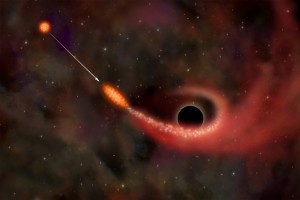In late March of 2011, an extraordinary event occurred: a black hole in a distant galaxy tore apart and ate a whole star (I wrote about this twice at the time; here’s the original post, and a followup article including a Hubble image of the event).
Now, there’s more info: the black hole, lying at the center of a galaxy nearly 4 billion light years away, has about 8 million times the mass of the Sun. When it tore the star apart, about half the mass of the star swirled around the black hole, forming twin beams of matter and energy that blasted outward at a large fraction of the speed of light. The folks at NASA’s Goddard Space Flight Center made a great animation to show this:
The star was ripped apart by tides. The thing about black holes is, they’re small: this one was probably about 15 million kilometers across. A typical star is about a million km across (the Sun is 1.4 million kilometers in diameter, for comparison). This means the star could get really close to the black hole, and that’s why it was doomed. The force of gravity drops with distance, so as the star approached, the side of it facing the black hole felt a far greater force than the size facing away. That stretched the star, and the stretching increased as the star got closer. At some point, the force was so great it exceeded the star’s own gravity, and it could no longer hold on to its material. The black hole won – as they usually do.
 The material from the shredded star formed a disk around the black hole, and near the center heated up to millions of degrees as it swirled around at near the speed of light. For reasons not entirely understood, this forms the beams of matter that jet away from the hole, and as it happens one of these beams was aimed pretty much right at us (not to worry, though, since at that vast distance the light was so diminished it took Hubble to see it in visible light at all). That’s what alerted us to the event in the first place; it was detected by the Swift satellite, which was designed to look for high-energy blasts from space.
The material from the shredded star formed a disk around the black hole, and near the center heated up to millions of degrees as it swirled around at near the speed of light. For reasons not entirely understood, this forms the beams of matter that jet away from the hole, and as it happens one of these beams was aimed pretty much right at us (not to worry, though, since at that vast distance the light was so diminished it took Hubble to see it in visible light at all). That’s what alerted us to the event in the first place; it was detected by the Swift satellite, which was designed to look for high-energy blasts from space.
Normally, things like this fade pretty quickly, but in this case, amazingly, it’s still pouring out energy and will probably be detectable even into 2012. That is partly due to relativity: because we’re looking straight down the beam of material, we see its clock ticking more slowly. This effect works better when the material is moving at high speed, and radio observations show that the blast is still expanding away from the black hole at half the speed of light! And that’s after it slowed down by ramming into material floating in between the stars in that galaxy. It started out moving at more than 90% the speed of light.
The energy it takes to do this is mind-numbing: we’re talking about roughly an octillion tons of matter screaming outward at well over one hundred thousand kilometers per second!
It literally makes the hair on the back of my neck stand up. I’m glad this happened billions of light years away.
Astronomers will continue to observe this event to learn more about it. It probably happens all the time in the Universe, but this is the first time we’ve had the equipment to really get a good look (even if we have to crane our necks a bit from 4 billion light years away). We’re not really sure how often something like this happens, or how it affects the galactic environment. I’ll note I’m not terribly worried about it happening in our Milky Way (we have a 4 million solar mass black hole in the center of our galaxy), since, after all, we’re here. If this happened often enough to be dangerous, we wouldn’t be here to talk about it!
But it might make an interesting movie plot. Hmmmmm…
Credits: Video: NASA; Artist’s illustration of star and black hole: NASA/CXC/M.Weiss.
Related posts:
- Astronomers may have witnessed a star torn apart by a black hole
- Followup on the star torn apart by a black hole
- Most distant object ever seen… maybe
- Cosmic X-ray blast temporarily blinded NASA satellite